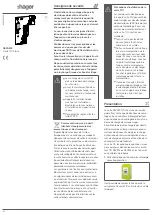
RS-422/485 Connections/Operation
32
Chapter 8
Document Number 3PCI-0712m
RS-422/485 Differential Signals
In RS-422 and RS-485 interfaces signals are sent on differential pairs. In the idle, or
Mark, state, the TDA(-) line will be 0V with respect to (wrt) ground and the TDB(+) line
will be about 4.4V wrt ground. Sensing differentially across the two lines, the voltage will
be
–4.4V (representing a Mark state). When the transmitter changes to the Space state
TDA(-) goes to +4.4V and TDB(+) goes to 0V. In that state the differential voltage will be
+4.4V
Figure 15. Differential transmitter/receiver
The receiver input is a differential circuit which senses the difference in voltage across
the transmission line as described above. In addition, any common mode noise picked
up equally on both wires of the twisted pair is cancelled. Receiver sensitivity is rated at
200mV. A separate signal ground/common connection provides a common mode
reference for the transmitter and receiver (and is often used to ground a shield in the
cable). These factors provide reliable communications at much greater distances than
RS-232.
RS-422 Operation
In RS-422 mode, the transmitter is enabled (TX ENABLE) all the time, and the receiver
is enabled (RX ENABLE) all the time. Typical point-to-point connections use a
transmitter and receiver at each end with two wire pairs connecting them. The transmit
lines of the device at one end of the link are connected to the matching receive lines of
the device at the other end. The second device transmit lines are connected to the
receive lines of the first.
Another common connection mode
—point to multipoints—connects the transmit pair
from the master device transmitter to the receive lines of many listening slave devices.
In this scenario the communications is one-way. None of the listening devices have
transmitters connected to reply to the master.
Содержание 3PCIOU1
Страница 53: ...Connector Pinouts Document Number 3PCI 0712m Appendix B B 1 Figure 31 2 Wire RS 485 Wiring...
Страница 54: ......
















































